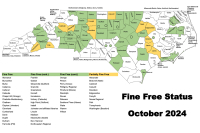A waiting game: WNC counties hope for continued PILT funding
 From Clingmans Dome to Juneywank Falls to the winding Blue Ridge Parkway, Swain County is rich in natural beauty. But all that public land can make the budget tight for county government, which depends on property tax for much of its revenue.
From Clingmans Dome to Juneywank Falls to the winding Blue Ridge Parkway, Swain County is rich in natural beauty. But all that public land can make the budget tight for county government, which depends on property tax for much of its revenue.
In Swain County, 87 percent of the land is in federal ownership, primarily under the national park and national forest system. Since the federal government doesn’t pay property taxes on its land, only 55,000 acres out Swain’s total of 350,000 acres are taxable.
And that means PILT payments — or payment in lieu of taxes — that the county receives from the federal government are important to maintaining its services. But those dollars might not materialize this year if the U.S. Senate joins the House of Representatives in passing a budget proposal that leaves PILT out.
“If it was cut this year, in a budget our size that would be significant,” said Kevin King, Swain County manager. “Four-point-five percent is not something that can be easily absorbed.”
Swain County, which has the fourth highest amount of federal land of any county east of the Mississippi, currently receives $570,000 per year from the program, down from $593,000 before the federal sequester cuts took effect in March 2013. In a general budget of $13 million, those numbers account for 4.5 percent of the county’s funding.
Related Items
“It’s very important to us,” King said.
King estimates that if federally-owned land in Swain County were left undeveloped but in private hands, the county would net about $10 million in property taxes from it. That’s about 17 times more than the county currently receives from PILT. Still, the program allows counties like Swain, Macon, Haywood, Cherokee and Jackson — which constitute five of the six North Carolina counties that receive the most PILT money — to reap the benefits of public land while recouping some of the lost revenue potential.
“Anytime you take that (money) out of there, you’re forced to find somewhere to make that difference,” said Derek Roland, manager of Macon County, which receives $332,000 from PILT. “That’s an often arduous task.”
National parks and forests contribute significantly to the lifestyle and economy of Western North Carolina, but their presence also puts the surrounding communities in a quandary.
“On the one hand the parks are a draw. On the other hand, they also increase the services counties have to provide without the ability to draw down property taxes, their primary sources of revenue,” said Ira Dove, interim manager of Haywood County. Dove said the county is entitled to some form of compensation to make up for its inability to draw property taxes from federally owned land.
But Roland and King are hopeful that the money will come through, and local representatives are pushing to make that happen.
“The senator is certainly supportive of full PILT funding for counties in North Carolina,” said Chris Moyer, press secretary to Senator Kay Hagan, D-N.C.
Hagan joined 16 other senators representing both parties and a diversity of states in signing a letter to the Senate Appropriations Committee to support continuing the payments. Though Republican North Carolina Sen. Richard Burr did not sign the letter, his office said that he is also in favor of full PILT funding.
These developments, in addition to efforts by U.S. Congressman Mark Meadows, R-Cashiers, and lobbying organizations leave local government hopeful for continued funding.
“I think that hard work by our representative (Meadows) and organizations like the North Carolina Association of County Commissioners is going to pay off,” said Roland, “and I think you will see those dollars included in the budget.”
And for PILT advocates like King, who has lobbied with the National Association of Counties for 15 years as the only representative to D.C. from an eastern state, the current situation is just another obstacle on a typically bumpy road.
“We’ve had to fight for it every year,” said King. “It’s not something new to here. It happens a lot.”
Though King has seen instances in which one house of Congress or another votes to exclude PILT funding from the preliminary budget, the program has never gone completely unfunded. However, it has dipped as low as 70 cents per acre as opposed to the current funding level of $1.78 per acre or the full amount of $2.17 per acre.
So, while King isn’t too worried yet, he and other local government representatives are anxiously awaiting Congress’ final decision. King traveled to D.C. in September to lobby for PILT funding.
“Everyone we talked to was very aware of the economic impact PILT would have if we did not fund it,” King said. “Some counties would basically have to shut their doors.”
A brief history of the PILT program
Oct. 1976 — President Gerald Ford signs the Payment in Lieu of Taxes Act into law. The act appropriates $100 million for distribution to counties in which federal land exists.
1994 — Amendments to the PILT Act tie payments to the Consumer Price Index to adjust the population limitation and per acre rate as opposed to appropriating a blanket amount.
Oct. 3, 2008 — The Emergency Economic Stabilization Act, also known as the bailout bill, provides mandatory funding for PILT from fiscal year 2008 until fiscal year 2012.
Dec. 12, 2013 — The U.S. House of Representatives passes the Ryan-Murry Budget Deal, which does not include al agreement for PILT funding.
By the numbers
Counties get annual compensation from the federal government based on the amount of national park and forest land within the county. Since counties can’t collect property taxes on national park and forest lands, the “payments in lieu of taxes” help offset the impact of federal land holdings in a county.
Here’s what each county gets in PILT payments annually and the acres of federally-owned land they include.
Swain: $577,301, 239,725 acres
Macon: $338,741, 153,078 acres
Haywood: $306,409, 130,522 acres
Graham: $231,898, 113,391 acres
Transylvania: $201,529, 89,310 acres
Cherokee: $199,245, 93,222 acres
Jackson: $193,316, 80,289 acres
Clay: $158,836, 65,969 acres
Madison: $119,721, 55,140 acres
Total: 43 counties in North Carolina received $3.997 million
Source: U.S. Department of the Interior









